TechRadar Verdict
The Q950T sees Samsung retain its place at the top of the 3D audio soundbar league. It combines Samsung’s customary fearsome power with enhanced precision and dynamism by providing 14 separate channels of sound. Plus, its slimmer shape will see it fit under a wider range of TVs too.
Pros
- +
Outstandingly powerful sound
- +
Unprecedented channel support
- +
Tasteful and slender design
Cons
- -
Expensive for a soundbar
- -
Unhelpfully positioned display
- -
No auto-calibration system
Why you can trust TechRadar
One-minute review
The Samsung HW-Q950T soundbar isn't the newest model on the shelf (an honor that belongs to the newer Samsung HW-Q950A) but it does remain a top contender on our list of the best soundbars. Despite being a few years old, the former flagship ups the channel count from its predecessor to a remarkable Dolby Atmos / DTS:X-friendly 9.1.4 configuration, despite sporting a slimmer form, and introduces a host of genuinely useful new smart features. All without costing more than its illustrious HW-Q90R predecessor.
Overall, the 9.1.4 system is pretty remarkable for a soundbar, and is clearly tailor-made for the object-based sound delights of today’s Dolby Atmos and DTS:X audio formats. Audio streaming is supported over both Wi-Fi and Bluetooth, which includes Hi-Res Audio file formats, and even lets you connect with certain phones just by tapping them against the soundbar’s bodywork.
Physical connectivity is fair for a premium soundbar, comprising two HDMI inputs, one HDMI output (with eARC support for obtaining lossless Dolby Atmos / DTS:X soundtracks from compatible TVs) and an optical digital audio input.
The Q950T’s sound quality is, in a word, incredible. At its heart is the ability to deliver even the most dense, most layered and most complex of movie mixes with huge amounts of power, and without a hint of weakness or distortion from any of the system’s many speakers. The sound can fill even huge living rooms with a fantastically large, complete and immersive bubble of audio, delivering levels of bass depth, mid-range openness and treble detailing that haven’t been heard before outside of a strong, large-speakered system.
Price and availability
- The HW-Q950T is widely available across the world
- It costs £1,499/$1,399/AUS$1949
- A 7.1.2-channel version without the rear speakers, the Q900T, is also available
The Q950T is Samsung’s top-end soundbar for 2020, so it’s no surprise to find it wearing a top-end price. As we’ll see, however, you do get plenty for your £1,499/$1,399/AUS$1,949 in terms of raw power, speaker channels and features.
The closest rival to the Q950T right now – in that both offer full Dolby Atmos speaker setups, including front and rear height channel drivers – is probably the LG SN11RG. This comes in £200 cheaper but, unlike the Q950T, doesn’t carry rear side-channel drivers.
In particular, the Q950T would make the ideal partner to Samsung’s latest high-end TVs thanks to its Q-Symphony feature, which allows the speakers in the TV and the soundbar to work together, adding extra height and presence to the soundstage.
Also available is the Q900T, a version of the Q950T without included rear speakers, which costs £1,099/£1,099/AU$1,549.
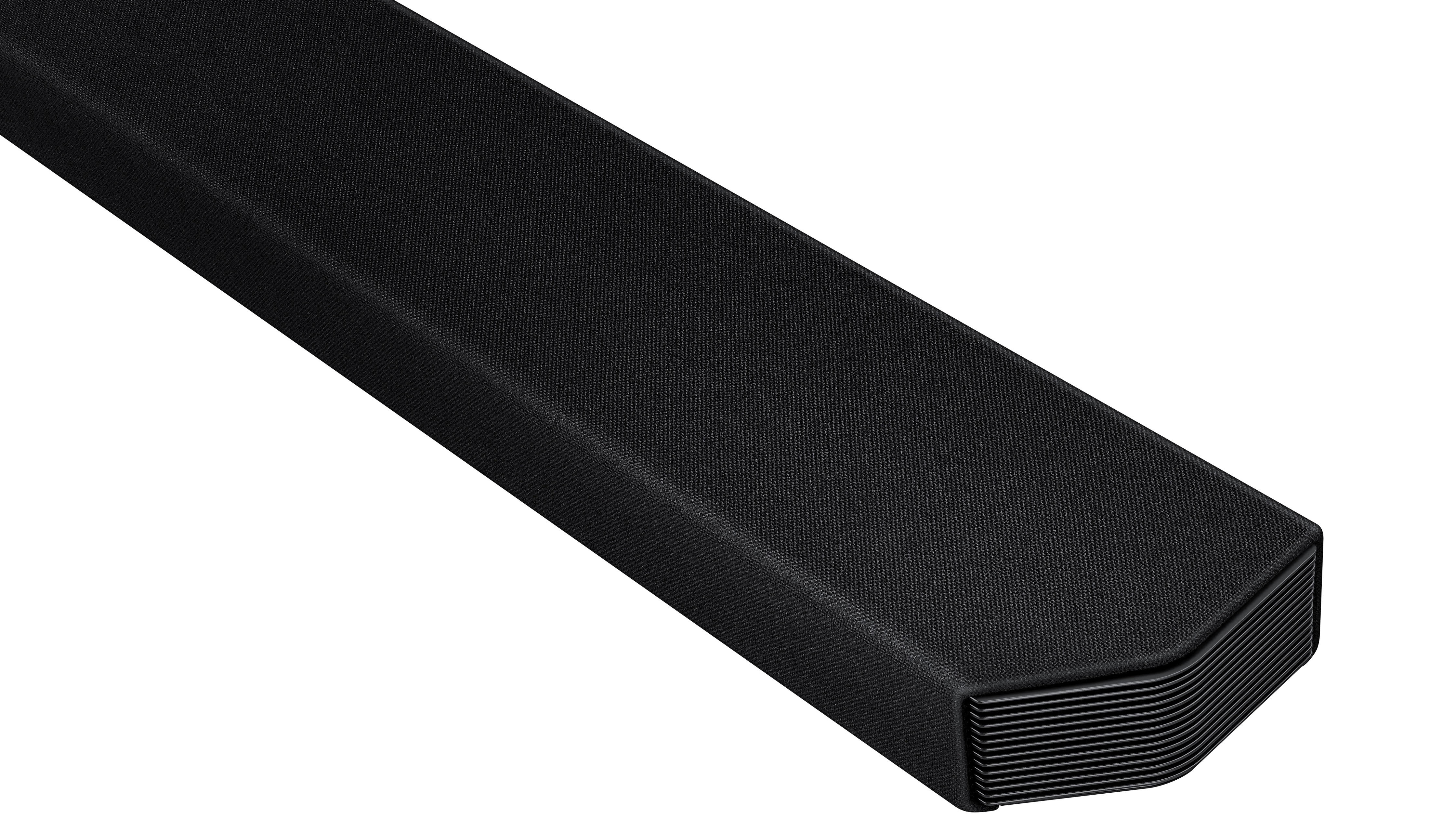
Design and features
- Slimmer profile for the main soundbar
- Wireless subwoofer and rear speakers included
- 9.1.4 channel configuration
At first glance, the Q950T’s compact but robust rears and hulking subwoofer don’t look very different to those of its HW-Q90R predecessor. It turns out there is a difference, though: the introduction of Kvadrat cloth covering each speakers’ drivers.
Personally, I preferred the older design, at least where the rears are concerned, but in truth you’re unlikely to see a noticeable difference from a distance.
The main soundbar element looks very different to that of the Q90R. For starters, at just 69.5mm it’s almost 14mm slimmer. While this may not sound like much on paper, in the flesh it’s significant – and means the Q950T will fit more easily under a wider range of TVs.
The Q950T’s main bar also replaces the metallic finish of old with black Kvadrat felt for its front and top edges.
However, the biggest design change finds the front corners of the soundbar now angling back at around 45 degrees. Not only does this work to make the soundbar more attractive, this design tweak reflects the inclusion of two new left-surround and right-surround speakers (for a 9.1.4 configuration), which reflect sound off your walls to create a more ‘filled in’ circle of sound around you.
As with the previous flagship Q90R system, the ‘.4’ part of this configuration refers to two upfiring drivers in the soundbar, plus one in each rear speaker.
One bizarre misstep in the Q950T’s design update finds its LED moving from the front edge to the top edge of the speaker’s rear; you can only actually see it when you’re standing next to it. It’s partnered in this daft new position by a button for toggling on and off a new built-in, Alexa-enabled far-field mic.
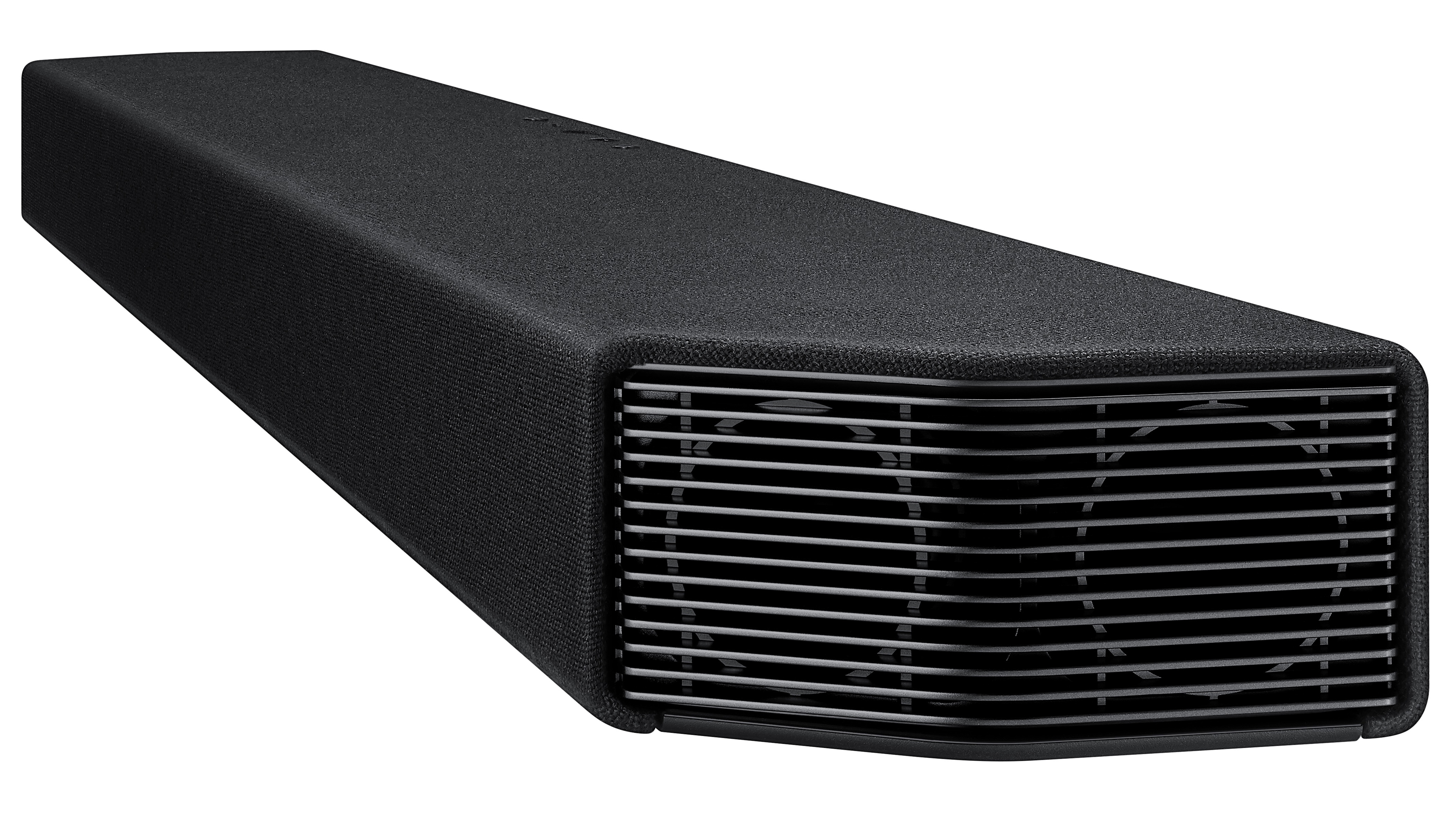
As far as indicators on the Q950T’s front edge are concerned, when you’re sat down you’ll see a tiny trio of lights that illuminate to register volume changes, and a small red light that illuminates if you have the far-field mic turned off.
All 20 of the drivers that go into producing the Q950T’s 14 channels of sound have been designed at Samsung’s US-based Audio Lab. Being able to do everything in-house has enabled Samsung to refine some aspects of the drivers. The main left, right and centre channels all benefit from dual woofers and wide-range tweeters, for instance, while the upfirers boast new processing that aims to broaden the overhead soundstage’s coverage and impact.
Physical connectivity is fair for a premium soundbar, with two HDMI inputs, one HDMI output (with eARC support for obtaining lossless Dolby Atmos / DTS:X soundtracks from compatible TVs) and an optical digital audio input. A third HDMI input and possibly a USB port for playing audio from USB drives would have been welcome, but what’s included should suffice for most people.
If you happen to have a Samsung phone running Android 8.1 or higher, you can connect it wirelessly to the soundbar simply by tapping the phone against the main soundbar’s chassis. Plus, as you would expect, there are also Bluetooth and Wi-Fi connection options for streaming audio from other networked sources.
The Wi-Fi support in conjunction with Samsung’s SmartThings phone/tablet app enables streaming from Apple Music, Amazon Music, Samsung Music, Spotify, TuneIn and Deezer accounts, while the audio file format support takes in Hi-Res Audio, AAC, MP3, OGG, FLAC, ALAC and AIFF.
Dolby Atmos and DTS:X content causes the soundbar to default to those playback modes, but there are a trio of processing modes available for ‘enhancing’ other audio content. The most interesting of these are a Game Pro mode, which claims to create a more immersive experience, and Adaptive Sound, which automatically tries to select the best audio experience based on real-time analysis of the content you’re playing.
One last key new feature is Q-Symphony. If you have a compatible Samsung TV then this feature will enable you to combine the soundbar’s audio with the TV’s speakers to create a larger soundstage.
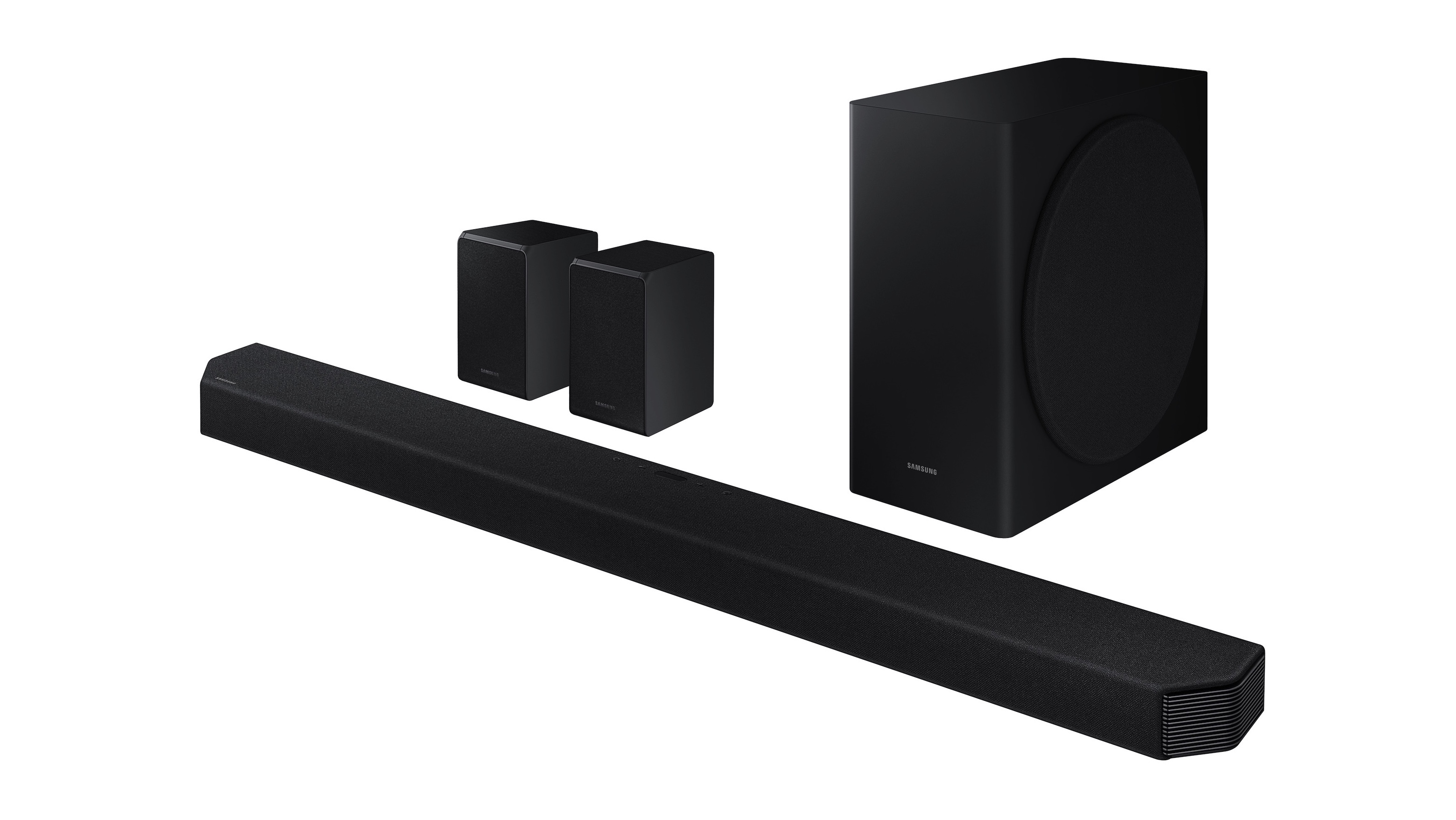
Audio performance
- Bags of power and detail
- Fully rounded 3D audio experience
- Meaty bass from the subwoofer
Worries that moving to a slimmer design might have compromised the Q950T’s sound quality are shattered into pieces within just seconds of firing it up. In fact, it sounds more powerful than its foundation-rocking predecessor.
The system is capable of hitting huge volumes – far beyond anything most ears will tolerate – without so much as a hint of rattling, distortion or fuzziness from any of its many drivers. Nor does the sound start to muddy in the mid-range or suffer harsh trebles as you start to drive it harder. In fact, if anything, the sound just gets better, more open and dynamic, the louder you drive it.
Dynamic range is huge for a soundbar. Not least because the subwoofer delivers the sort of hugely deep rumbles you’d normally only expect to get with a high-end system of separates. Even the massive bass drops at the start of Blade Runner 2049 present no problem for the Q950T – and there’s no tougher bass test in the movie world than that.
However, the subwoofer is nimble enough to vary its output in terms of both frequency and volume, too, avoiding that ‘all or nothing’ trap into which soundbar subwoofers sometimes fall.
The subwoofer’s nimbleness combined with the almost inexplicably wide dynamic range of the main soundbar element means that bass levels still feel like an integrated part of the soundstage. They don’t just hang distractingly off the bottom of the mix.
Voices sound both fantastically clear but also perfectly contextualised – and, crucially, they’re delivered with a wide enough dispersion to sound to make them appear as if they’re coming from the images onscreen, not trapped inside the soundbar.
The Q950T isn’t just about explosive power, though. In fact, one of the most obvious improvements over its predecessor is the subtlety with which it picks out even the tiniest details in a Dolby Atmos or DTS:X mix. Birds tweeting, distant dogs barking, leaves gently stirring in the breeze, creaking floorboards, chirruping crickets… not only are all such sounds perfectly audible without exaggeration or shrillness, they’re perfectly placed too.
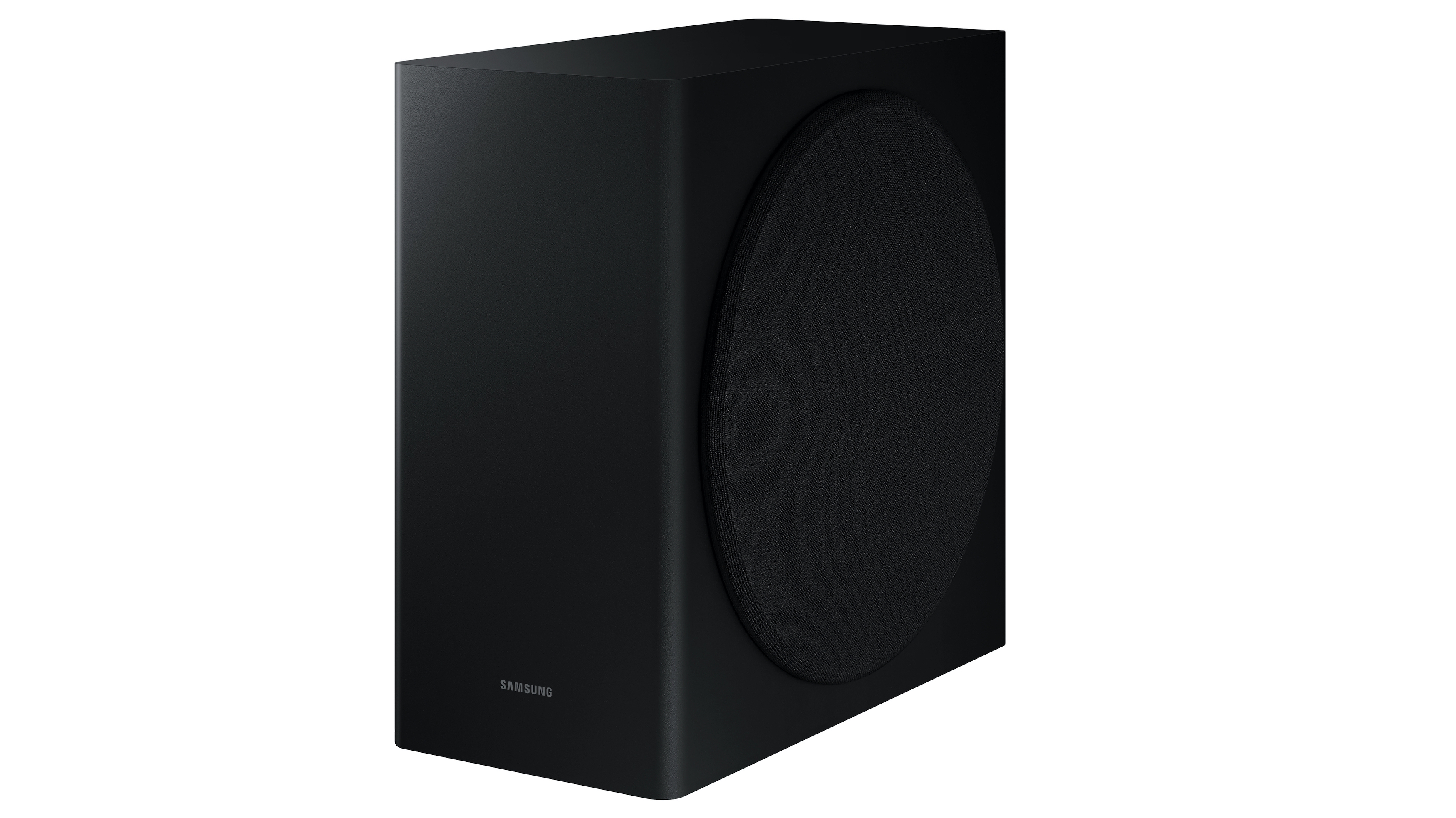
This placement of effects is as impressive in the rear speakers as it is in the main soundbar, revealing the Q950T’s rear speakers to be more sensitive and willing to get involved than those of its predecessor. In fact, the whole three-dimensional staging of the object-based sound formats is significantly improved over the Q90R, despite that model being excellent in that respect, too.
The new rear side channels ensure there are no gaps in the sound, even down the sides of very large rooms, and the improved front/rear balance, together with the new height channel processing, ensures the familiar Dolby Atmos dome of sound never sounds uneven.
These improvements also pay off handsomely when it comes to accurately conveying sounds panning across a movie mix, either back to front or side to side.
One last point about the Q950T’s sound is that its abundance of power means it’s unprecedentedly good by soundbar standards at escalating its performance to meet even the most mammoth of mixes. So where the LG SN11RG’s presentation actually tends to step back when a big movie mix piles on the pressure, the Q950T just keeps upping the amps to take on pretty much anything. It’s genuinely spectacular.
Given the degree to which the Q950T is tuned for Dolby Atmos / DTS:X movies, I couldn’t help but be slightly apprehensive about how it would handle music. Happily, though, while its approach to music is certainly on the muscular side, the new drivers are sufficiently refined to ensure content feels balanced and convincing, with plenty of subtle detail, a pleasing stereo presence, and slightly elevated (vertically) vocals that never sound either shrill or swallowed.
The dynamic range continues to be prodigious with music, too, hitting bass levels you probably never knew existed in your favourite songs, ensuring low frequencies never become over-dominant or thuddy.
I’d recommend sticking with the Standard playback mode for music, since Adaptive mode tends to get too aggressive/over dynamic, and the Surround and Game modes can sound a bit artificial.
Finally, using the Game mode for the purpose for which it’s intended is pretty interesting. With non-Dolby Atmos game soundtracks (Atmos tracks default to the soundbar’s Atmos mode), the Game preset doesn’t only generate a more intense-sounding surround sound experience, but it actually manages to create what feels like an object-based, three-dimensional soundstage, where sound effects seem to appear from thin air rather than just from the speakers.
I’d still use a Dolby Atmos or DTS:X mixer in a PC or games console where one is available, but the Q950T’s Game mode is worth trying with other gaming systems.
Should I buy the Samsung HW-Q950T?
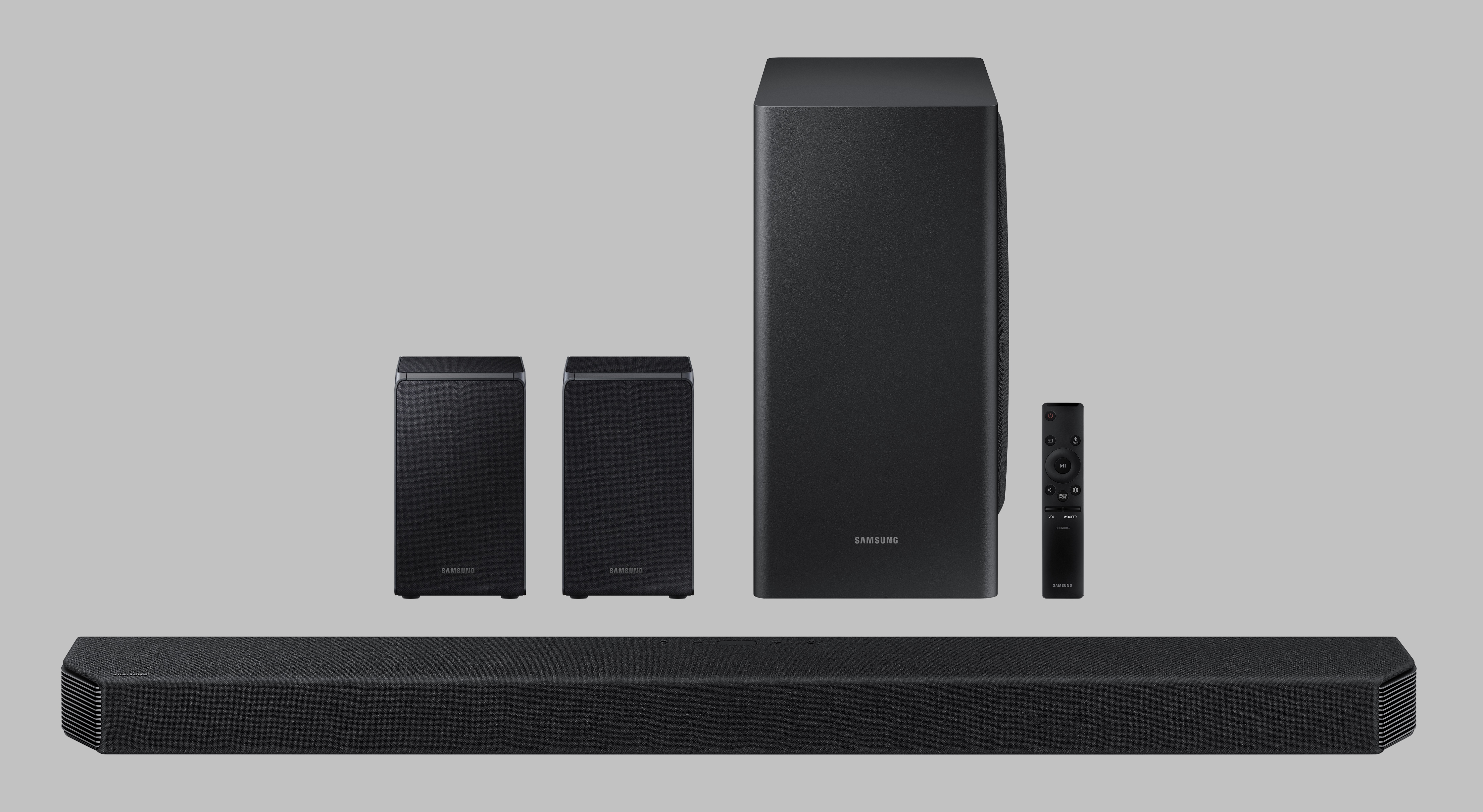
Buy it if...
You want fantastic movie sound
No other soundbar can rival the Q950T for raw power and dynamic range, and its unprecedented channel count helps it create a peerlessly immersive soundstage.
You want compact speakers in your living room
While you could get a decent system of separates for the money the Q950T costs, the Samsung system gives you much, if not all, of the performance of such a system from a remarkably compact set of speakers.
You want to use your soundbar with a wide range of sources
As well as carrying two HDMIs and an optical audio port, the Q950T features easy-to-set-up Bluetooth and Wi-Fi support. If you have an Android 8.1 Samsung phone, you can even connect it to the soundbar by simply tapping it on the soundbar’s bodywork.
Don’t buy it if...
The size of speakers doesn’t bother you
If you do some research, you may be able to put together a sound system of separates that could slightly outperform the Q950T. But be aware that such a system would leave your room cluttered with relatively large speakers and spools of cabling.
You don’t want rear speakers
If space is limited, or you just don’t like black boxes sitting all around your living room, you could do away with the Q950T’s rear speakers – and save yourself a few hundred quid – by opting for the Q900T system instead.
You don’t have cash to spare
While its power and performance justify its £1,499/$1,399/AUS$1,949 asking price, this is still a lot of money to spend on a surround sound audio system. If money is tight, and you understand the performance compromises involved (or have a very small living room), you could pick up a decent soundbar/subwoofer system for around a third of the price.
Looking to save money on a Samsung product? Check out our Samsung promo codes for the latest deals on top-rated tech and gadgets.
- Check out our pick of the best soundbars too
John has been writing about home entertainment technology for more than two decades - an especially impressive feat considering he still claims to only be 35 years old (yeah, right). In that time he’s reviewed hundreds if not thousands of TVs, projectors and speakers, and spent frankly far too long sitting by himself in a dark room.
